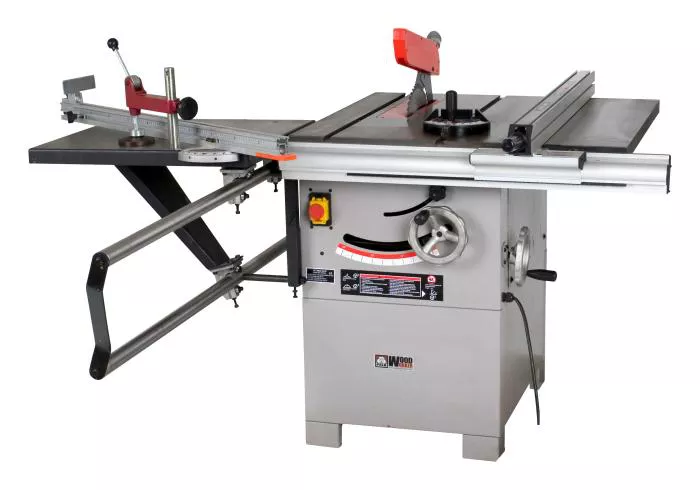Table saws are essential power tools for woodworkers. These machines feature circular blades mounted on an arbor. The blade protrudes through a slot in a flat work surface. Users push materials against the blade to make precise cuts.
Three primary types exist: benchtop, contractor, and cabinet saws. Benchtop models are most common in budget categories. They’re lightweight and portable. Contractor saws offer more power but cost more. Cabinet saws are professional-grade machines.
Key components include the blade, fence, miter gauge, and rip capacity. The fence guides material during cuts. Miter gauges help with angled cuts. Rip capacity determines maximum cut width.
Critical Features in Affordable Table Saws
Motor power matters significantly. Budget saws typically have 10-15 amp motors. More amps mean better cutting performance. However, higher amps increase costs.
Blade size affects cutting depth. Standard diameters are 8-10 inches. Larger blades cut thicker materials. Most sub-$100 saws use 8-inch blades.
Safety features are crucial. Look for blade guards and anti-kickback pawls. Some models include riving knives. These prevent material from pinching the blade.
Build quality impacts durability. Metal components last longer than plastic. Check the table surface flatness. Warped surfaces cause inaccurate cuts.
Top Value Picks for Cost-Conscious Buyers
Compact Benchtop Performer
This lightweight model suits small workshops. It weighs under 40 pounds for easy transport. The 8-inch blade handles most DIY projects.
Notable features include a steel roll cage. This protects internal components. The modular blade guard enhances safety. Users report decent cutting accuracy.
Drawbacks include limited rip capacity. The fence extends only 20 inches. This restricts wider cuts. Vibration occurs during heavy use.
Entry-Level Woodworking Solution
A popular choice among beginners. It features a 15-amp motor for solid performance. The 10-inch blade cuts through 2×4 lumber easily.
Key advantages include tool-free blade changes. The rack-and-pinion fence adjusts smoothly. Dust collection ports help maintain cleanliness.
Limitations involve noise levels. The motor runs louder than premium models. The miter gauge has slight play. This affects angle cut precision.
Portable Jobsite Companion
Designed for contractors on tight budgets. It folds into a compact form for transport. The stand provides stability during operation.
Standout aspects include onboard storage. This keeps accessories organized. The overload protection prevents motor burnout.
Challenges include table size. The work surface feels cramped for large sheets. Fence alignment requires frequent checking.
Performance Comparison
Cutting tests reveal interesting differences. The 15-amp model cuts hardwood fastest. All saws struggle with dense hardwoods. Softwoods like pine cut easily.
Accuracy varies between models. The rack-and-pinion fence provides most consistency. Basic fence designs show measurement drift.
Vibration levels impact finish quality. Models with better bases produce smoother cuts. Lightweight units shake during operation.
Safety Considerations
Proper setup prevents accidents. Always verify blade alignment before use. Ensure the fence runs parallel to the blade.
Personal protective equipment is mandatory. Wear safety glasses and hearing protection. Avoid loose clothing near moving parts.
Kickback represents the biggest danger. Use push sticks for narrow cuts. Never stand directly behind the workpiece.
Maintenance Requirements
Regular cleaning extends tool life. Remove sawdust after each use. Lubricate moving parts monthly.
Blade care affects performance. Clean pitch buildup with specialized solutions. Replace dull blades immediately.
Electrical components need inspection. Check cords for damage regularly. Ensure proper grounding on all tools.
Upgrade Possibilities
Aftermarket blades improve results. Carbide-tipped versions stay sharper longer. Thin-kerf blades reduce material waste.
Fence upgrades enhance precision. Some third-party systems offer micro-adjustment. These cost more than the saw itself.
Dust collection accessories help. Many budget saws lack effective ports. Attach a shop vacuum for better cleanup.
Project Suitability
These saws handle basic tasks well. They rip plywood sheets adequately. Crosscutting lumber works fine.
Limitations appear with complex work. Dado cuts require special blades. Most budget saws lack arbor length for stacked cutters.
Fine woodworking demands more precision. Consider higher-end tools for furniture making. These budget options suit rough construction.
Cost Versus Quality Analysis
Extremely low prices involve compromises. Expect more plastic components. Bearings and gears wear faster.
The sweet spot balances price and features. Models near $100 often outperform cheaper alternatives. They last longer with moderate use.
Professional use justifies higher investment. These budget saws work for occasional projects. Daily operation requires heavier-duty tools.
User Experience Insights
Beginners appreciate simple controls. Clear measurement scales help learning. Basic models have fewer adjustment points.
Experienced users notice limitations. Fence wiggle affects repeat cuts. Table flatness becomes apparent during joinery.
Hobbyists find these adequate. Serious woodworkers quickly outgrow them. The upgrade path becomes obvious with use.
Environmental Factors
Workspace size affects choice. Small garages need compact units. The folding stand model saves floor space.
Power availability matters. All these saws run on standard 120V circuits. No special wiring requirements exist.
Noise considerations apply. These aren’t quiet tools. Apartment workshops need sound mitigation.
Accessory Recommendations
Essential additions include push blocks. These keep hands away from blades. Featherboards improve cut consistency.
Measurement tools help accuracy. A good combination square verifies setups. Digital angle finders assist with bevels.
Work supports handle long materials. Roller stands prevent sheet goods from sagging. Outfeed tables help with large pieces.
Long-Term Value Assessment
Cheapest options may cost more eventually. Frequent replacements add up. Better-built models last years.
Resale value remains low. These are disposable tools at this price. Don’t expect significant recovery at resale.
Total cost includes blades and accessories. Factor these into budget calculations. The initial price isn’t the whole story.
Conclusion
Budget table saws under $100 serve specific needs well. They’re perfect for beginners learning fundamentals. Casual DIYers find them sufficient for basic projects. The best choices balance core features with build quality. Safety remains paramount regardless of price. While limitations exist, these tools provide real functionality at accessible prices. Careful selection yields satisfactory results without breaking the bank.
Relate topics:
- Compact Table Saw: A Comprehensive Review
- Best Table Saw for the Money: A Comprehensive Evaluation
- Ridgid Table Saw: A Comprehensive and Objective Evaluation

